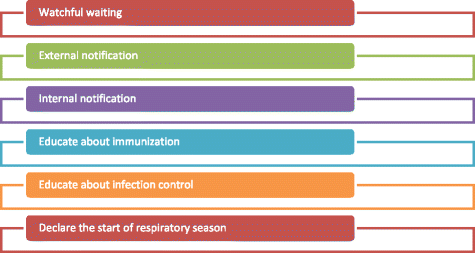Evaluation of the ability of standardized supports to improve public health response to syndromic surveillance for respiratory diseases in Canada
- PMID: 28202020
- PMCID: PMC5311860
- DOI: 10.1186/s12889-017-4073-6
Evaluation of the ability of standardized supports to improve public health response to syndromic surveillance for respiratory diseases in Canada
Abstract
Background: Despite widespread implementation of syndromic surveillance systems within public health agencies, previous studies of the implementation and use of these systems have indicated that the functions and responses taken in response to syndromic surveillance data vary widely according to local context and preferences. The objective of the Syndromic Surveillance Evaluation Study was to develop and implement standardized supports in local public health agencies in Ontario, Canada, and evaluate the ability of these supports to affect actions taken as part of public health communicable disease control programs.
Methods: Local public health agencies (LPHA) in Ontario, which used syndromic surveillance based on emergency department visits for respiratory disease, were recruited and randomly allocated to the study intervention or control group. The intervention group health agencies received standardized supports in terms of a standardized aberrant event detection algorithm and a response protocol dictating steps to investigate and assess the public health significance of syndromic surveillance alerts. The control group continued with their pre-existing syndromic surveillance infrastructure and processes. Outcomes were assessed using logbooks, which collected quantitative and qualitative information about alerts received, investigation steps taken, and public health responses. The study was conducted prospectively for 15 months (October 2013 to February 2015).
Results: Fifteen LPHAs participated in the study (n = 9 intervention group, n = 6 control group). A total of 1,969 syndromic surveillance alerts were received by all LPHAs. Variations in the types and amount of responses varied by LPHA, in particularly differences were noted by the size of the health unit. Smaller health units had more challenges to both detect and mount a response to any alerts. LPHAs in the control group were more likely to declare alerts to have public health significance and to initiate any action. Regression models using repeated measures showed an interaction between the year (Year 1 versus Year 2) and the intervention as well as an interaction between year and sustained nature of the alert. Both of these were linked to the control health units reporting more "watchful waiting".
Conclusions: This study raises questions about the effectiveness of using standardized protocols to improve the performance of syndromic surveillance in a decentralized public health system. Despite efforts to create standardized protocols and engage public health agencies in the process, no significant differences in the effective use of syndromic alerts were observed beyond year 1. It also raises questions about the minimum capacity of the agency and minimum population size that are required for an effective response.
Figures
Similar articles
-
Should we be worried? Investigation of signals generated by an electronic syndromic surveillance system--Westchester County, New York.MMWR Suppl. 2004 Sep 24;53:190-5. MMWR Suppl. 2004. PMID: 15717391
-
Implementation of an automated, real-time public health surveillance system linking emergency departments and health units: rationale and methodology.CJEM. 2008 Mar;10(2):114-9. doi: 10.1017/s1481803500009817. CJEM. 2008. PMID: 18371248
-
Direct cost associated with the development and implementation of a local syndromic surveillance system.J Public Health Manag Pract. 2007 Mar-Apr;13(2):194-9. doi: 10.1097/00124784-200703000-00017. J Public Health Manag Pract. 2007. PMID: 17299325
-
Real-time syndrome surveillance in Ontario, Canada: the potential use of emergency departments and Telehealth.Eur J Emerg Med. 2004 Feb;11(1):3-11. doi: 10.1097/00063110-200402000-00002. Eur J Emerg Med. 2004. PMID: 15167186 Review.
-
Syndromic Surveillance Systems for Mass Gatherings: A Scoping Review.Int J Environ Res Public Health. 2022 Apr 13;19(8):4673. doi: 10.3390/ijerph19084673. Int J Environ Res Public Health. 2022. PMID: 35457541 Free PMC article.
Cited by
-
Designing a Syndromic Bovine Mortality Surveillance System: Lessons Learned From the 1-Year Test of the French OMAR Alert Tool.Front Vet Sci. 2020 Jan 9;6:453. doi: 10.3389/fvets.2019.00453. eCollection 2019. Front Vet Sci. 2020. PMID: 31998757 Free PMC article.
-
Emergency department syndromic surveillance systems: a systematic review.BMC Public Health. 2020 Dec 9;20(1):1891. doi: 10.1186/s12889-020-09949-y. BMC Public Health. 2020. PMID: 33298000 Free PMC article.
References
MeSH terms
Grants and funding
LinkOut - more resources
Full Text Sources
Other Literature Sources


